Deposition of W Nanoparticles by Magnetron Sputtering Gas Aggregation Using Different Amounts of H2/Ar and Air Leaks
Abstract
1. Introduction
2. Materials and Methods
3. Results and Discussion
3.1. Deposition Rate Evolution in the Presence of H2 Injected in Discharge—The Influence of Air Leaks
3.2. Morphological Investigations of W NPs—The Effect of Variable Amounts of H2 Injected into Discharge
3.3. Morphological Investigations of W NPs—The Effect of Air Leaks in the Discharge
3.4. Chemical Composition of the W Dust—Influence of the Air Leaks
4. Conclusions
Author Contributions
Funding
Institutional Review Board Statement
Informed Consent Statement
Data Availability Statement
Conflicts of Interest
References
- Lassner, E.; Schubert, W.-D. Tungsten; Springer US: Boston, MA, USA, 1999; ISBN 978-1-4613-7225-7. [Google Scholar]
- Pai, C.-F.; Liu, L.; Li, Y.; Tseng, H.W.; Ralph, D.C.; Buhrman, R.A. Spin Transfer Torque Devices Utilizing the Giant Spin Hall Effect of Tungsten. Appl. Phys. Lett. 2012, 101, 122404. [Google Scholar] [CrossRef]
- Costa, M.; Costa, A.T.; Hu, J.; Wu, R.Q.; Muniz, R.B. β-Tungsten: A Promising Metal for Spintronics. J. Phys. Condens. Matter 2018, 30, 305802. [Google Scholar] [CrossRef] [PubMed]
- Abdelhameed, A.H.; Angloher, G.; Bauer, P.; Bento, A.; Bertoldo, E.; Canonica, L.; Fuchs, D.; Hauff, D.; Iachellini, N.F.; Mancuso, M.; et al. Deposition of Tungsten Thin Films by Magnetron Sputtering for Large-Scale Production of Tungsten-Based Transition-Edge Sensors. J. Low Temp. Phys. 2020, 199, 401–407. [Google Scholar] [CrossRef]
- Filipescu, M.; Ion, V.; Colceag, D.; Ossi, P.M.; Dinescu, M. Growth and Characterizations of Nanostructured Tungsten Oxides. Rom. Rep. Phys. 2012, 64, 1213–1225. [Google Scholar]
- Palla-Papavlu, A.; Filipescu, M.; Schneider, C.W.; Antohe, S.; Ossi, P.M.; Radnóczi, G.; Dinescu, M.; Wokaun, A.; Lippert, T. Direct Laser Deposition of Nanostructured Tungsten Oxide for Sensing Applications. J. Phys. D Appl. Phys. 2016, 49, 205101. [Google Scholar] [CrossRef]
- Filipescu, M.; Ossi, P.M.; Dinescu, M. WOx Cluster Formation in Radio Frequency Assisted Pulsed Laser Deposition. Appl. Surf. Sci. 2007, 254, 1347–1351. [Google Scholar] [CrossRef]
- Dong, C.; Zhao, R.; Yao, L.; Ran, Y.; Zhang, X.; Wang, Y. A Review on WO3 Based Gas Sensors: Morphology Control and Enhanced Sensing Properties. J. Alloys Compd. 2020, 820, 153194. [Google Scholar] [CrossRef]
- Zhu, J.; Wei, S.; Zhang, L.; Mao, Y.; Ryu, J.; Mavinakuli, P.; Karki, A.B.; Young, D.P.; Guo, Z. Conductive Polypyrrole/Tungsten Oxide Metacomposites with Negative Permittivity. J. Phys. Chem. C 2010, 114, 16335–16342. [Google Scholar] [CrossRef]
- Marcu, M.; Preda, L.; Vizireanu, S.; Bita, B.; Mihai, M.A.; Spataru, T.; Acsente, T.; Dinescu, G.; Spataru, N. Enhancement of the Capacitive Features of WO3 Supported on Pristine and Functionalized Graphite by Appropriate Adjustment of the Electrodeposition Regime. Mater. Sci. Eng. B 2022, 277, 115585. [Google Scholar] [CrossRef]
- Coman, L.G.; Marcu, M.; Acsente, T.; Vizireanu, S.; Satulu, V.; Dinescu, G.; Matei, E.; Spataru, T.; Spataru, N.; Preda, L. Hybrid Nanostructures Based on Vertically Graphenes Decorated with Tungsten Oxide Nanoparticles for Enhanced Capacitive Performance. Diam. Relat. Mater 2023, 139, 110316. [Google Scholar] [CrossRef]
- You, J.H.; Visca, E.; Barrett, T.; Böswirth, B.; Crescenzi, F.; Domptail, F.; Fursdon, M.; Gallay, F.; Ghidersa, B.-E.; Greuner, H.; et al. European Divertor Target Concepts for DEMO: Design Rationales and High Heat Flux Performance. Nucl. Mater. Energy 2018, 16, 1–11. [Google Scholar] [CrossRef]
- Winter, J.; Gebauer, G. Dust in Magnetic Confinement Fusion Devices and Its Impact on Plasma Operation. J. Nucl. Mater. 1999, 266–269, 228–233. [Google Scholar] [CrossRef]
- Rosanvallon, S.; Grisolia, C.; Delaporte, P.; Worms, J.; Onofri, F.; Hong, S.H.; Counsell, G.; Winter, J. Dust in ITER: Diagnostics and Removal Techniques. J. Nucl. Mater. 2009, 386–388, 882–883. [Google Scholar] [CrossRef]
- Arnas, C.; Campos, A.; Diez, M.; Peillon, S.; Martin, C.; Hassouni, K.; Michau, A.; Bernard, E.; Fedorczac, N.; Gensdarmes, F.; et al. Micron-Sized Dust and Nanoparticles Produced in the WEST Tokamak. Nucl. Mater. Energy 2023, 36, 101471. [Google Scholar] [CrossRef]
- Huttel, Y. Gas-Phase Synthesis of Nanoparticles, 1st ed.; Wiley: New York, NY, USA, 2017. [Google Scholar]
- Haberland, H.; Karrais, M.; Mall, M. A New Type of Cluster and Cluster Ion Source. Z. Für Phys. D At. Mol. Clusters 1991, 20, 413–415. [Google Scholar] [CrossRef]
- Solař, P.; Škorvánková, K.; Kuzminova, A.; Kylián, O. Challenges in the Deposition of Plasma Polymer Nanoparticles Using Gas Aggregation Source: Rebounding upon Impact and How to Land Them on a Substrate. Plasma Process. Polym. 2023, 20, e2300070. [Google Scholar] [CrossRef]
- Choukourov, A.; Pleskunov, P.; Nikitin, D.; Titov, V.; Shelemin, A.; Vaidulych, M.; Kuzminova, A.; Solař, P.; Hanuš, J.; Kousal, J.; et al. Advances and Challenges in the Field of Plasma Polymer Nanoparticles. Beilstein J. Nanotechnol. 2017, 8, 2002–2014. [Google Scholar] [CrossRef] [PubMed]
- Acsente, T.; Istrate, M.C.; Satulu, V.; Bita, B.; Dinescu, G. Operation of a Magnetron Sputtering Gas Aggregation Cluster Source in a Plasma Jet Regime for Synthesis of Core–Shell Nanoparticles. J. Phys. D Appl. Phys. 2021, 54, 02LT01. [Google Scholar] [CrossRef]
- Yin, F.; Wang, Z.W.; Palmer, R.E. Controlled Formation of Mass-Selected Cu–Au Core–Shell Cluster Beams. J. Am. Chem. Soc. 2011, 133, 10325–10327. [Google Scholar] [CrossRef]
- Benelmekki, M.; Vernieres, J.; Kim, J.-H.; Diaz, R.-E.; Grammatikopoulos, P.; Sowwan, M. On the Formation of Ternary Metallic-Dielectric Multicore-Shell Nanoparticles by Inert-Gas Condensation Method. Mater. Chem. Phys. 2015, 151, 275–281. [Google Scholar] [CrossRef]
- Acsente, T.; Negrea, R.F.; Nistor, L.C.; Logofatu, C.; Matei, E.; Birjega, R.; Grisolia, C.; Dinescu, G. Synthesis of Flower-like Tungsten Nanoparticles by Magnetron Sputtering Combined with Gas Aggregation. Eur. Phys. J. D 2015, 69, 161. [Google Scholar] [CrossRef]
- Acsente, T.; Negrea, R.F.; Nistor, L.C.; Matei, E.; Grisolia, C.; Birjega, R.; Dinescu, G. Tungsten Nanoparticles with Controlled Shape and Crystallinity Obtained by Magnetron Sputtering and Gas Aggregation. Mater. Lett. 2017, 200, 121–124. [Google Scholar] [CrossRef]
- Acsente, T.; Stoica, S.D.; Craciun, C.; Mitu, B.; Dinescu, G. Enhancement of W Nanoparticles Synthesis by Injecting H 2 in a Magnetron Sputtering Gas Aggregation Cluster Source Operated in Ar. Plasma Chem. Plasma Process. 2024; preprint. [Google Scholar] [CrossRef]
- Acsente, T.; Gabriela Carpen, L.; Matei, E.; Bita, B.; Negrea, R.; Bernard, E.; Grisolia, C.; Dinescu, G. Tungsten Nanoparticles Produced by Magnetron Sputtering Gas Aggregation: Process Characterization and Particle Properties. In Progress in Fine Particle Plasmas; IntechOpen: London, UK, 2020. [Google Scholar]
- Marek, A.; Valter, J.; Kadlec, S.; Vyskočil, J. Gas Aggregation Nanocluster Source—Reactive Sputter Deposition of Copper and Titanium Nanoclusters. Surf. Coat Technol. 2011, 205, S573–S576. [Google Scholar] [CrossRef]
- Hihara, T.; Sumiyama, K. Formation and Size Control of a Ni Cluster by Plasma Gas Condensation. J. Appl. Phys. 1998, 84, 5270–5276. [Google Scholar] [CrossRef]
- Peter, T.; Polonskyi, O.; Gojdka, B.; Mohammad Ahadi, A.; Strunskus, T.; Zaporojtchenko, V.; Biederman, H.; Faupel, F. Influence of Reactive Gas Admixture on Transition Metal Cluster Nucleation in a Gas Aggregation Cluster Source. J. Appl. Phys. 2012, 112, 114321. [Google Scholar] [CrossRef]
- Valentina, M.; Anca, B. Algorithm-Based Methods as Information Source for Plasma-Material Interaction Studies—An Overview. In Proceedings of the International Scientific Conference SEA-CONF, Constanta, Romania, 21–22 May 2021; pp. 252–259. [Google Scholar]
- Budtz-Jørgensen, C.V.; Kringhøj, P.; Bøttiger, J. The Critical Role of Hydrogen for Physical Sputtering with Ar–H2 Glow Discharges. Surf. Coat Technol. 1999, 116–119, 938–943. [Google Scholar] [CrossRef]
- Kratochvíl, J.; Kuzminova, A.; Kylián, O.; Biederman, H. Comparison of Magnetron Sputtering and Gas Aggregation Nanoparticle Source Used for Fabrication of Silver Nanoparticle Films. Surf. Coat Technol. 2015, 275, 296–302. [Google Scholar] [CrossRef]
- Smirnov, B.M. Processes Involving Clusters and Small Particles in a Buffer Gas. Uspekhi Fiz. Nauk. 2011, 181, 713. [Google Scholar] [CrossRef]
- Kamiura, Y.; Umezawa, K.; Teraoka, Y.; Yoshigoe, A. Characterization of Polycrystalline Tungsten Surfaces Irradiated with Nitrogen Ions by X-Ray Photoelectron Spectroscopy. Mater. Trans. 2016, 57, 1609–1614. [Google Scholar] [CrossRef]
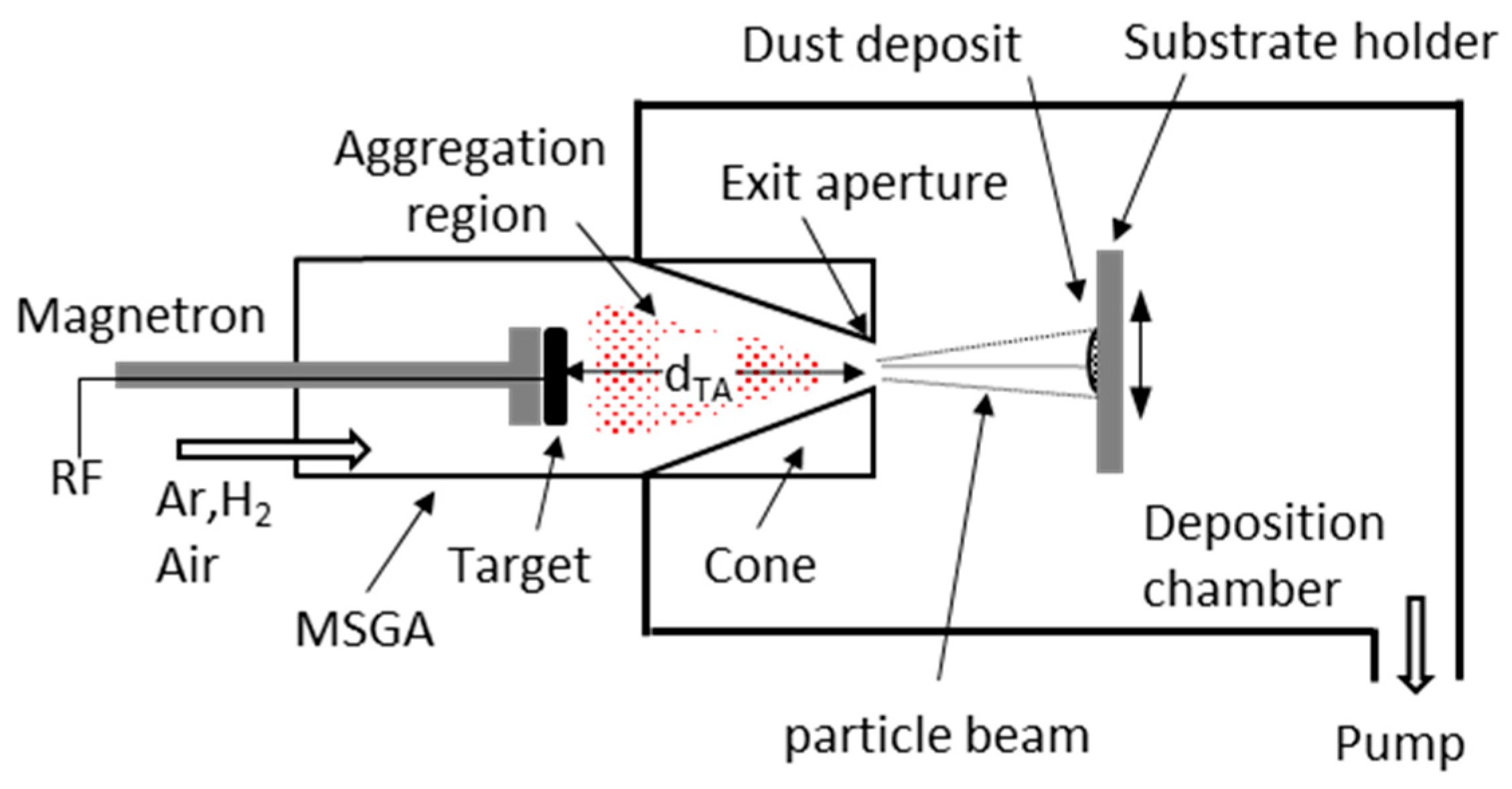
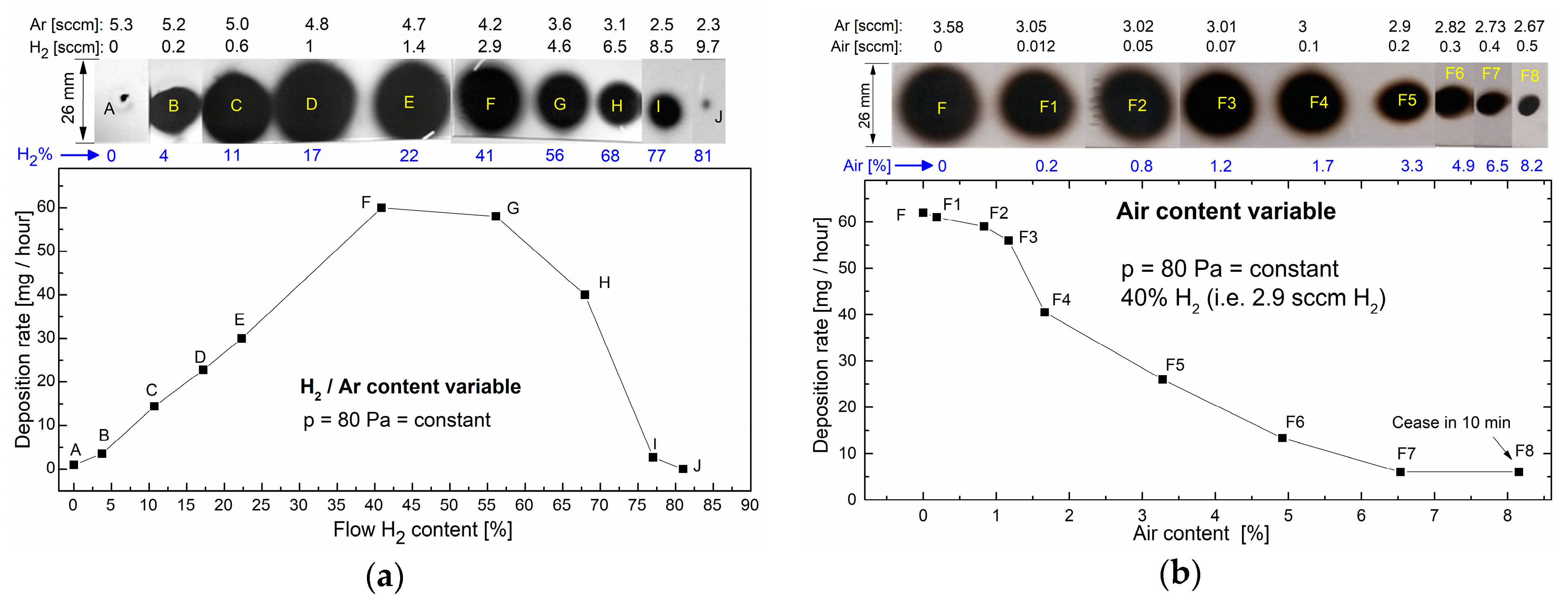
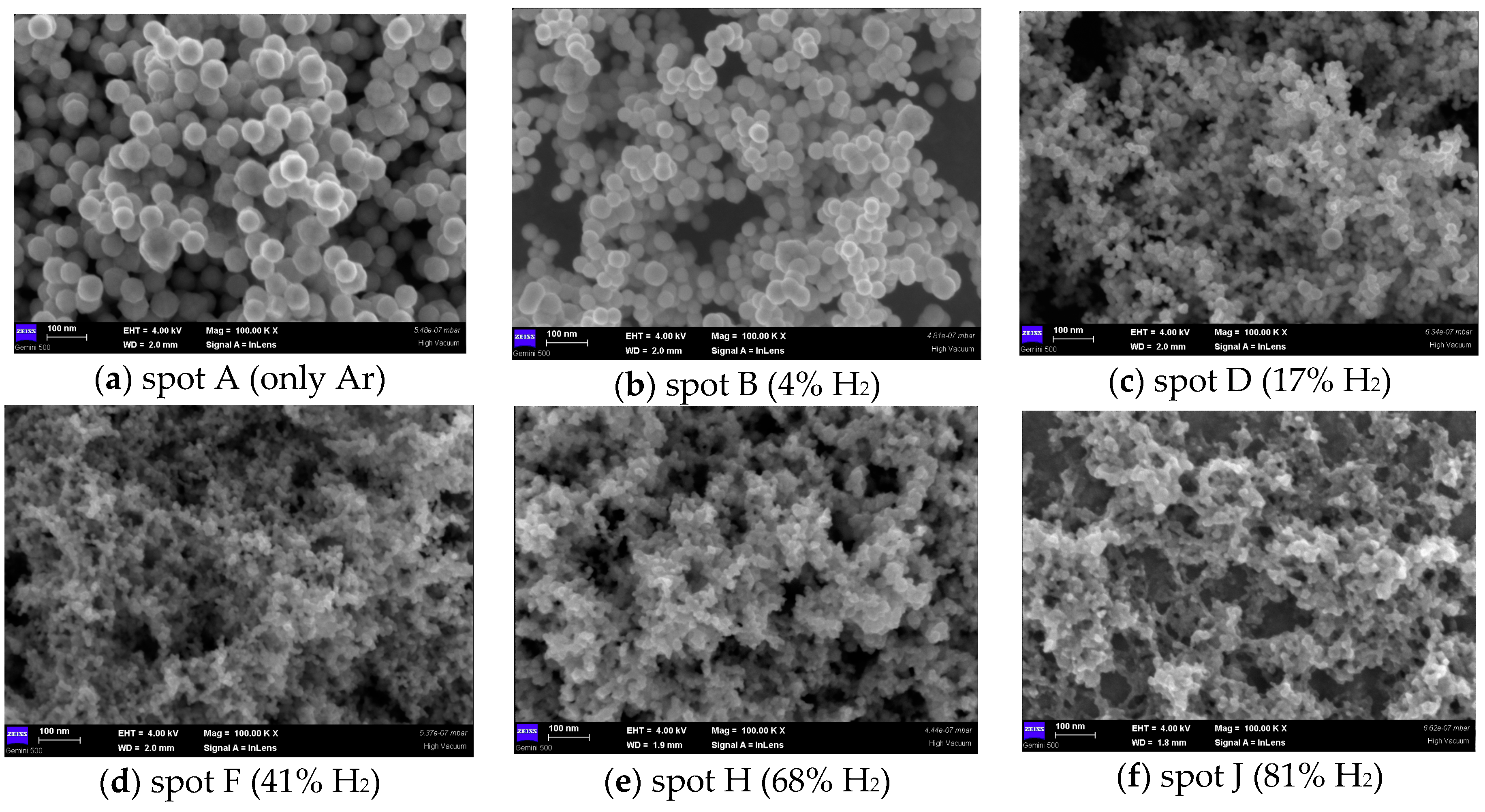
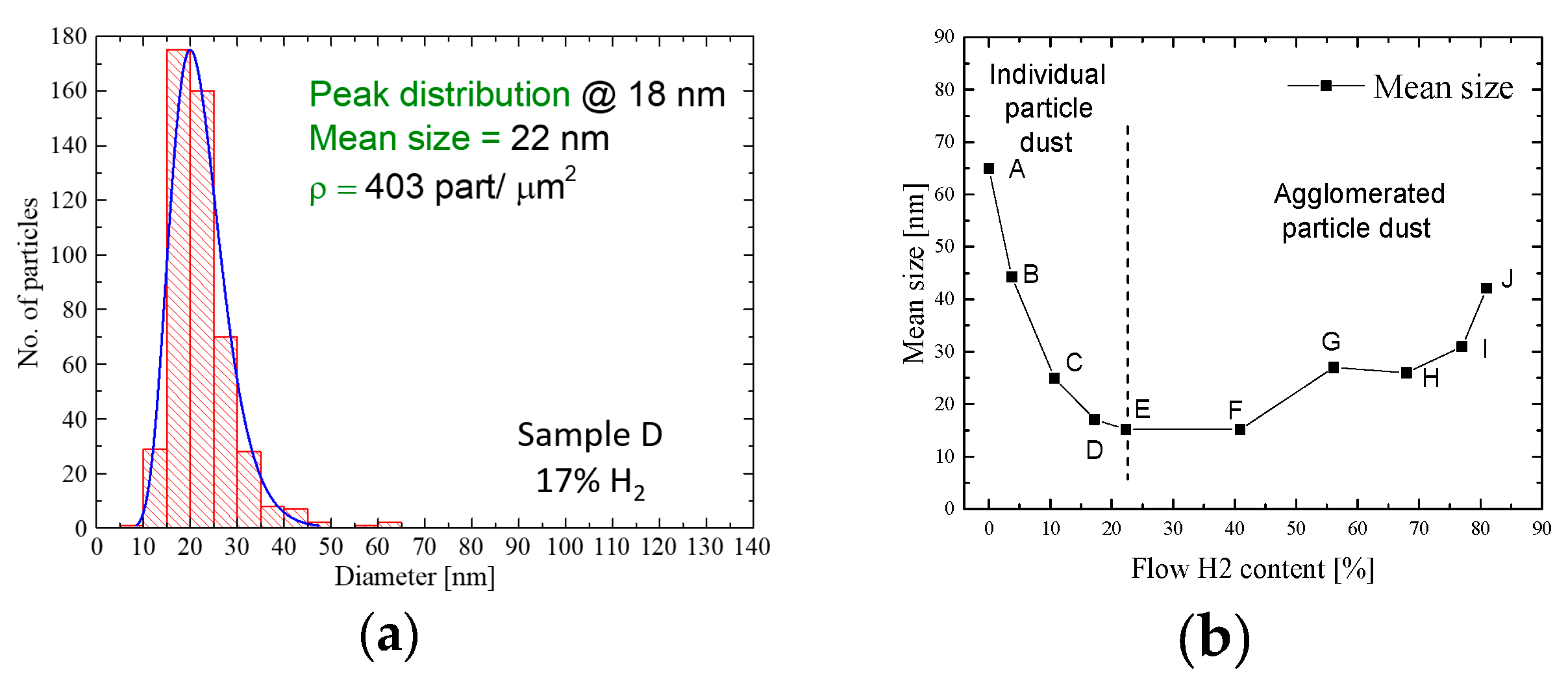


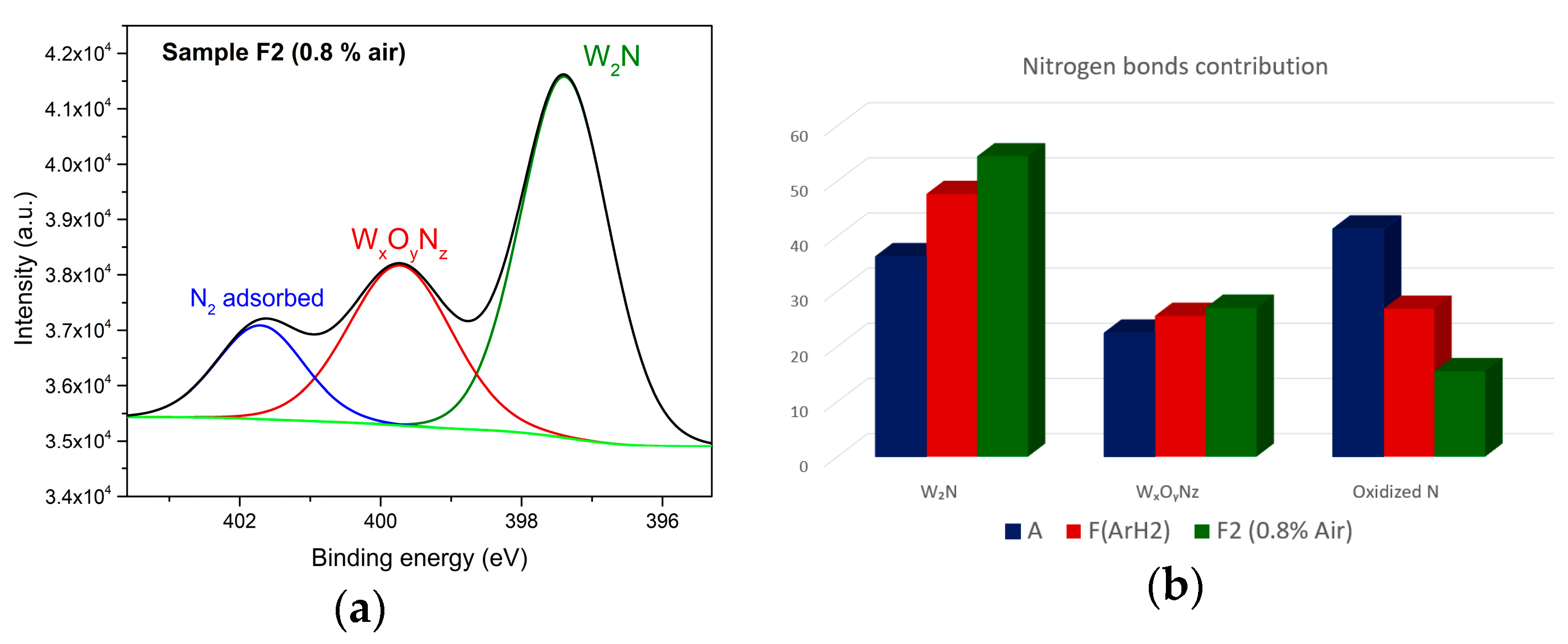
Disclaimer/Publisher’s Note: The statements, opinions and data contained in all publications are solely those of the individual author(s) and contributor(s) and not of MDPI and/or the editor(s). MDPI and/or the editor(s) disclaim responsibility for any injury to people or property resulting from any ideas, methods, instructions or products referred to in the content. |
© 2024 by the authors. Licensee MDPI, Basel, Switzerland. This article is an open access article distributed under the terms and conditions of the Creative Commons Attribution (CC BY) license (https://creativecommons.org/licenses/by/4.0/).
Share and Cite
Acsente, T.; Matei, E.; Marascu, V.; Bonciu, A.; Satulu, V.; Dinescu, G. Deposition of W Nanoparticles by Magnetron Sputtering Gas Aggregation Using Different Amounts of H2/Ar and Air Leaks. Coatings 2024, 14, 964. https://doi.org/10.3390/coatings14080964
Acsente T, Matei E, Marascu V, Bonciu A, Satulu V, Dinescu G. Deposition of W Nanoparticles by Magnetron Sputtering Gas Aggregation Using Different Amounts of H2/Ar and Air Leaks. Coatings. 2024; 14(8):964. https://doi.org/10.3390/coatings14080964
Chicago/Turabian StyleAcsente, Tomy, Elena Matei, Valentina Marascu, Anca Bonciu, Veronica Satulu, and Gheorghe Dinescu. 2024. "Deposition of W Nanoparticles by Magnetron Sputtering Gas Aggregation Using Different Amounts of H2/Ar and Air Leaks" Coatings 14, no. 8: 964. https://doi.org/10.3390/coatings14080964
APA StyleAcsente, T., Matei, E., Marascu, V., Bonciu, A., Satulu, V., & Dinescu, G. (2024). Deposition of W Nanoparticles by Magnetron Sputtering Gas Aggregation Using Different Amounts of H2/Ar and Air Leaks. Coatings, 14(8), 964. https://doi.org/10.3390/coatings14080964






